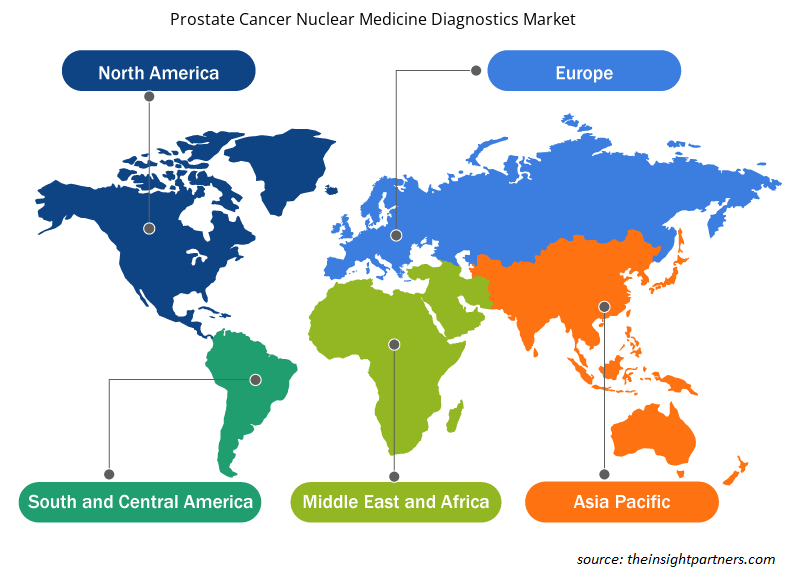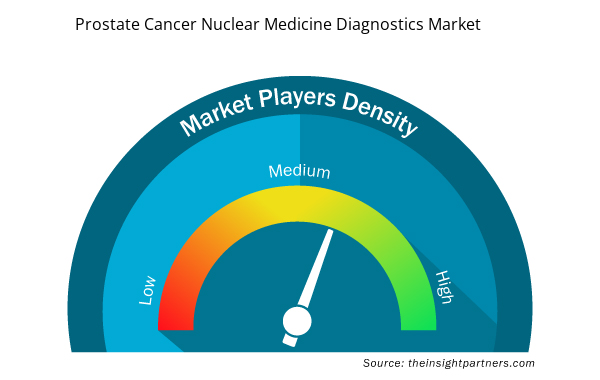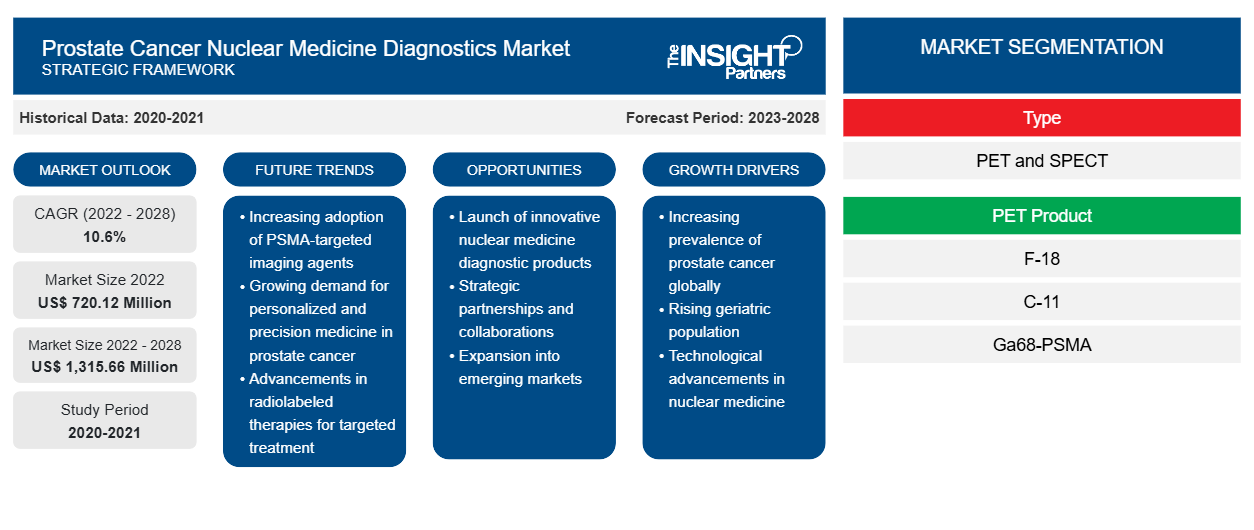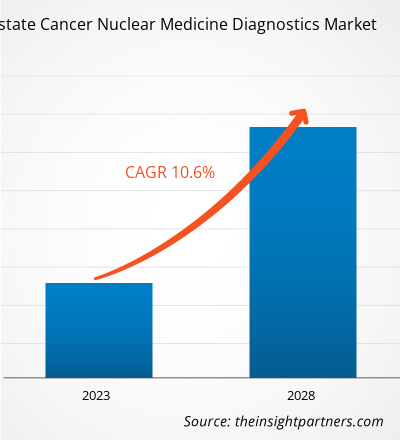Der Markt für nuklearmedizinische Diagnostik von Prostatakrebs soll von 720,12 Millionen US-Dollar im Jahr 2022 auf 1.315,66 Millionen US-Dollar im Jahr 2028 wachsen. Von 2022 bis 2028 wird mit einer durchschnittlichen jährlichen Wachstumsrate von 10,6 % gerechnet.
Prostatakrebs betrifft die Prostatadrüsen bei Männern. Prostatakrebs ist nach Hautkrebs bei Männern eine häufige Krebsart. Einige häufige Faktoren, die für den Beginn von Prostatakrebs verantwortlich sind, sind Familiengeschichte, hohes Alter und Rasse. Nuklearmedizin ist eine Bildgebung, die radioaktive Materialien benötigt. Sie ist eine hilfreiche Methode zur Identifizierung und Behandlung von Prostatakrebs und hilft Radiologen, das Stadium des Krebses zu bestimmen.
Der Markt für nuklearmedizinische Diagnostik bei Prostatakrebs wird nach Typ, PET-Produkt, Endbenutzer und Geografie analysiert. Nach geografischer Lage ist der Markt grob in Nordamerika, Europa, Asien-Pazifik, den Nahen Osten und Afrika sowie Süd- und Mittelamerika unterteilt. Der Marktbericht zur nuklearmedizinischen Diagnostik bei Prostatakrebs bietet Einblicke und eine eingehende Analyse des Marktes und betont Parameter wie Markttrends, Marktdynamik und die Wettbewerbsanalyse der weltweit führenden Marktteilnehmer.
Passen Sie diesen Bericht Ihren Anforderungen an
Sie erhalten kostenlose Anpassungen an jedem Bericht, einschließlich Teilen dieses Berichts oder einer Analyse auf Länderebene, eines Excel-Datenpakets sowie tolle Angebote und Rabatte für Start-ups und Universitäten.
- Holen Sie sich die wichtigsten Markttrends aus diesem Bericht.Dieses KOSTENLOSE Beispiel umfasst eine Datenanalyse von Markttrends bis hin zu Schätzungen und Prognosen.
Markteinblicke
Steigende Nachfrage nach früher und präziser Diagnose von Prostatakrebs treibt den Markt für nuklearmedizinische Diagnostik bei Prostatakrebs an
Ein Anstieg des PSA- Werts erhöht das Risiko für Prostatakrebs. Der PSA- Wert im Blut wird in Nanogramm pro Milliliter ( ng / ml ) gemessen. Es gibt keinen definitiven Grenzwert, der bestimmen kann, ob ein Mann Prostatakrebs hat oder nicht. Bei der Beurteilung, ob ein Mann weitere Tests benötigt, wählen viele Ärzte einen PSA- Grenzwert von 4 ng / ml oder höher, während andere einen niedrigeren Wert wie 2,5 oder 3 empfehlen. Daher kann die Messung des PSA- Werts im Blut eines Mannes Prostatakrebs frühzeitig erkennen.
Eine digitale rektale Untersuchung ( DRE ) ist ein weiterer Ansatz zur Erkennung von Prostatakrebs. Der Arzt tastet während der Untersuchung die Prostatadrüse mit einem behandschuhten, geschmierten Finger ab. Regelmäßige Untersuchungen mit einem gut validierten Biomarker könnten zu einer schnelleren Erkennung lokaler Erkrankungen führen. Darüber hinaus ist die Unterscheidung zwischen niedrig- und hochgradigen Erkrankungen von entscheidender Bedeutung, um unnötige Biopsien, eine Unterbehandlung schwerer Erkrankungen und eine Überbehandlung indolenter Erkrankungen zu vermeiden.
Nachfolgend sind einige Beispiele für Unternehmen aufgeführt, die neue Produktentwicklungen und Produktzulassungen auf den Markt gebracht haben:
- Im April 2022 gab Telix bekannt, dass sein Mittel zur Bildgebung von Prostatakrebs, Illuccix (Kit zur Herstellung von Gallium-Ga-68 -Gozetotid ), auch bekannt als 68Ga-PSMA-11-Injektion, in den USA kommerziell erhältlich sein wird.
- Im März 2022 gab Novartis bekannt, dass die FDA Pluvicto (Lutetium Lu 177 Vipivotid Tetraxetan ) (früher bekannt als 177Lu-PSMA-617) zur Behandlung erwachsener Patienten mit prostataspezifischem Membranantigen-positivem metastasiertem kastrationsresistentem Prostatakrebs ( PSMA-positives mCRPC ) zugelassen hat, der sich auf andere Teile des Körpers ausgebreitet hat (metastasiert).
- Im März 2022 genehmigte die FDA ein ergänzendes diagnostisches Bildgebungsmittel, Locametz , nach radioaktiver Markierung mit Gallium-68 zur Identifizierung PSMA-positiver Läsionen. Nach der radioaktiven Markierung kann dieses Bildgebungsmittel verwendet werden, um PSMA-positive Läsionen bei erwachsenen Patienten mit mCRPC durch eine Positronen-Emissions-Tomographie zu identifizieren.
Solche Produktentwicklungen von Marktakteuren treiben den Markt für nuklearmedizinische Diagnostik von Prostatakrebs an.
Typ-Einblicke
Der globale Markt für nuklearmedizinische Diagnostik bei Prostatakrebs ist nach Typ in SPECT und PET unterteilt. Das PET-Segment hatte 2021 den größten Marktanteil. Darüber hinaus wird erwartet, dass dasselbe Segment im Prognosezeitraum die höchste durchschnittliche jährliche Wachstumsrate (CAGR) auf dem Markt verzeichnet. Die Akzeptanz von PET als Diagnoseinstrument nimmt deutlich zu, da es eine höhere Genauigkeit als andere Diagnosetechniken bietet. Die Genauigkeit der Diagnose hat direkte Auswirkungen auf Entscheidungsprozesse und Behandlungsüberwachungsprozesse. Die steigende Nachfrage nach diesen Diagnoseverfahren dürfte das Wachstum des Marktes für nuklearmedizinische Diagnostik bei Prostatakrebs im Prognosezeitraum ankurbeln.
Einblicke in unsere Dienstleistungen
Basierend auf PET-Produkten ist der globale Markt für nuklearmedizinische Diagnostik bei Prostatakrebs in F-18, C-11 und Ga68-PSMA unterteilt. Das F-18-Segment wird voraussichtlich im Jahr 2022 den größten Marktanteil halten. Es wird jedoch erwartet, dass das Ga68-PSMA-Segment im Prognosezeitraum die höchste durchschnittliche jährliche Wachstumsrate (CAGR) auf dem Markt verzeichnet. Ga68-PSMA ist ein nicht-invasiver Diagnoseansatz, der eine verstärkte Expression des prostataspezifischen Membranantigens (PSMA) zur Bildgebung von Prostatakrebs verwendet. PSMA ist ein Transmembranprotein, das in der gesamten Prostata vorkommt. Die PSMA-Expression ist bei einer Vielzahl von Krebsarten hochreguliert, aber Prostatakrebs weist die höchsten Werte auf. Darüber hinaus hat die PSMA-Expression einen prädiktiven Wert für den Krankheitsverlauf. PET erzeugt semiquantitative Bilder, die eine nicht-invasive Messung der PSMA-Expression ermöglichen, indem die dreidimensionale Verteilung von Ga68-PSMA gemessen wird.
Partnerschaften und Kooperationen sind bei den Akteuren auf dem globalen Markt für nuklearmedizinische Diagnostik bei Prostatakrebs weit verbreitete Strategien. Nachfolgend sind einige der jüngsten wichtigen Marktentwicklungen aufgeführt:
- Im April 2022 gab Telix eine Partnerschaft mit Avanço und THP bekannt, um das experimentelle Bildgebungsprodukt für Prostatakrebs von Telix auf den Märkten in Portugal, Österreich, der Tschechischen Republik und der Slowakischen Republik zu vertreiben.
- Im August 2022 veröffentlichte Telix Einzelheiten zu zwei Zusatzstudien im Rahmen des ProstACT-Programms, darunter eine Phase-II-Studie in Zusammenarbeit mit GenesisCare.
- Im Februar 2021 gab Theragnostics eine Forschungsvereinbarung mit dem Universitätsklinikum Essen bekannt, um THG-008 für die PET-Bildgebung bei verschiedenen Krebsarten zu untersuchen, da radioaktiv markierte PARP-Inhibitoren das Potenzial haben, das Überleben von Krebspatienten zu verbessern.
Der Ausbruch der COVID-19-Pandemie hat einige günstige Szenarien für Akteure auf dem Markt für nuklearmedizinische Diagnostik bei Prostatakrebs aufgezeigt. In ganz Nordamerika sind zahlreiche Menschen von COVID 19 betroffen. Die USA sind ein stark betroffenes Land in Nordamerika. Die Infektion hat die geriatrische Bevölkerung des Landes schwer getroffen, verschiedene Komplikationen verursacht und zum Tod eines großen Teils der Bevölkerung geführt. So meldeten die USA mit Stand vom 16. Mai 2022 84.230.829 COVID-Fälle mit 1.026.670 Todesfällen. Darüber hinaus treten chronische Wunden oder nicht heilende Wunden meist bei älteren Menschen auf und brauchen länger, um zu heilen. Daher sind nuklearmedizinische Diagnostik bei Prostatakrebs und die richtige Pflege erforderlich, um chronischen Infektionsfällen und Gesundheitszuständen vorzubeugen.
Darüber hinaus waren aufgrund des Ausbruchs von COVID-19 verschiedene Krankenhäuser mit der Behandlung der betroffenen Menschen beschäftigt. Die COVID-19-Epidemie führte zu einem deutlichen Rückgang der Krebsvorsorgeuntersuchungen. Die Epidemie hat jedoch in den Vereinigten Staaten zu einem allgemeinen Mangel an Vorsorgeuntersuchungen geführt. COVID-19-bedingte Verzögerungen bei Krebsvorsorgeuntersuchungen werden als Ursache für zusätzliche Todesfälle angesehen, die in direktem Zusammenhang mit der Epidemie stehen. Die Prostatabiopsie- und PC-Diagnoseraten gingen während der COVID-19-Pandemie zurück, insbesondere während des Höhepunkts des Ausbruchs.
Darüber hinaus litten die bildgebenden Dienste in Europa, vor allem in Großbritannien, vor der Pandemie unter chronischer Unterinvestition und mangelnder Kapazität für Bildaufnahme und Berichterstellung. Dies hing beispielsweise mit einem erheblichen Mangel an Arbeitskräften und Ausrüstung zusammen. Doch mit den neuen IPC-Maßnahmen, insbesondere dem sozialen Abstand von 2 m in allen Gesundheitseinrichtungen, haben diese Engpässe die CT-Kapazität zum Zeitpunkt der Abfassung dieses Artikels auf etwa 40–70 % des Niveaus vor COVID ausgeglichen. Auch die MRT ist mit 80 % etwas besser. Darüber hinaus arbeiten die bildgebenden Dienste hart daran, wieder an Dynamik zu gewinnen, indem sie ihre Kapazitäten wiederherstellen und das Vertrauen der Patienten zurückgewinnen. Es bleibt klar, dass grundlegende Änderungen nur mit erheblichen Investitionen zur Behebung der chronischen Unterfinanzierung von Radiologen, Röntgenassistenten und bildgebenden Geräten erreicht werden können.
Regionale Einblicke in den Markt für nuklearmedizinische Diagnostik bei Prostatakrebs
Die regionalen Trends und Faktoren, die den Markt für nuklearmedizinische Diagnostik bei Prostatakrebs im Prognosezeitraum beeinflussen, wurden von den Analysten von Insight Partners ausführlich erläutert. In diesem Abschnitt werden auch die Marktsegmente und die Geografie der nuklearmedizinischen Diagnostik bei Prostatakrebs in Nordamerika, Europa, im asiatisch-pazifischen Raum, im Nahen Osten und Afrika sowie in Süd- und Mittelamerika erörtert.

- Erhalten Sie regionale Daten zum Markt für nuklearmedizinische Diagnostik bei Prostatakrebs
Umfang des Marktberichts zur nuklearmedizinischen Diagnostik bei Prostatakrebs
| Berichtsattribut | Details |
|---|---|
| Marktgröße im Jahr 2022 | 720,12 Millionen US-Dollar |
| Marktgröße bis 2028 | 1.315,66 Millionen US-Dollar |
| Globale CAGR (2022 - 2028) | 10,6 % |
| Historische Daten | 2020-2021 |
| Prognosezeitraum | 2023–2028 |
| Abgedeckte Segmente | Nach Typ
|
| Abgedeckte Regionen und Länder | Nordamerika
|
| Marktführer und wichtige Unternehmensprofile |
|
Marktteilnehmerdichte im Bereich nuklearmedizinische Diagnostik bei Prostatakrebs: Auswirkungen auf die Geschäftsdynamik verstehen
Der Markt für nuklearmedizinische Diagnostik bei Prostatakrebs wächst rasant. Dies wird durch die steigende Nachfrage der Endnutzer aufgrund von Faktoren wie sich entwickelnden Verbraucherpräferenzen, technologischen Fortschritten und einem größeren Bewusstsein für die Vorteile des Produkts vorangetrieben. Mit der steigenden Nachfrage erweitern Unternehmen ihr Angebot, entwickeln Innovationen, um die Bedürfnisse der Verbraucher zu erfüllen, und nutzen neue Trends, was das Marktwachstum weiter ankurbelt.
Die Marktteilnehmerdichte bezieht sich auf die Verteilung der Firmen oder Unternehmen, die in einem bestimmten Markt oder einer bestimmten Branche tätig sind. Sie gibt an, wie viele Wettbewerber (Marktteilnehmer) in einem bestimmten Marktraum im Verhältnis zu seiner Größe oder seinem gesamten Marktwert präsent sind.
Die wichtigsten Unternehmen auf dem Markt für nuklearmedizinische Diagnostik bei Prostatakrebs sind:
- Blue Earth Diagnostics GmbH
- ImaginAB
- Curium
- Jubilant Radiopharma
- NCM-USA LLC
Haftungsausschluss : Die oben aufgeführten Unternehmen sind nicht in einer bestimmten Reihenfolge aufgeführt.

- Überblick über die wichtigsten Akteure auf dem Markt für nuklearmedizinische Diagnostik bei Prostatakrebs
Nuklearmedizinische Diagnostik bei Prostatakrebs – Marktsegmentierung
Der globale Markt für nuklearmedizinische Diagnostik bei Prostatakrebs wird nach Typ, PET-Produkt, Endverbraucher und Geografie analysiert. In Bezug auf den Typ ist der Markt in PET und SPECT unterteilt. Basierend auf dem PET-Produkt ist der Markt in F-18, C-11 und Ga68-PSMA segmentiert. Basierend auf dem Endverbraucher ist der Markt in Krankenhäuser, Kliniken und andere segmentiert. Geografisch ist der Markt für nuklearmedizinische Diagnostik bei Prostatakrebs in Nordamerika, Europa, Asien-Pazifik, Naher Osten und Afrika sowie Süd- und Mittelamerika segmentiert.
Firmenprofile
- Blue Earth Diagnostics GmbH
- ImaginAb
- Curium
- Jubilant Radiopharma
- NCM-USA LLC
- ABX advanced biochemical compounds GmbH
- Telix Pharmaceuticals Ltd.
- Novartis AG
- Theragnostik
- Lantheus Medical Imaging, Inc.
- Historische Analyse (2 Jahre), Basisjahr, Prognose (7 Jahre) mit CAGR
- PEST- und SWOT-Analyse
- Marktgröße Wert/Volumen – Global, Regional, Land
- Branche und Wettbewerbsumfeld
- Excel-Datensatz



Report Coverage
Revenue forecast, Company Analysis, Industry landscape, Growth factors, and Trends

Segment Covered
This text is related
to segments covered.

Regional Scope
North America, Europe, Asia Pacific, Middle East & Africa, South & Central America

Country Scope
This text is related
to country scope.
Häufig gestellte Fragen
The global prostate cancer nuclear medicine diagnostics market on region, is segmented into North America, Europe, Asia Pacific, Middle East & Africa, and the South & Central America. In 2021, North American region held largest market share. However, Asia Pacific region is estimated to grow at the fastest CAGR of 11.2% during the forecast period
The global prostate cancer nuclear medicine diagnostics market based on type, is segmented into SPECT and PET. In 2021, PET segment held largest market share and the segment is estimated to grow at the fastest CAGR of 10.8% during the forecast period.
The high cost related to the prostate cancer diagnostics and treatment is expected to restrict the market growth during the forecast period
The prostate cancer nuclear medicine diagnostics market majorly consists of the players such as Blue Earth Diagnostics Limited, ImaginAB, Curium, Jubilant Radiopharma, NCM-USA LLC, ABX Advanced Biochemical Compounds GmbH, Telix Pharmaceuticals Ltd., Novartis AG, Theragonostics, and Lantheus Medical Imaging Inc.
Factors such as the rising prevalence of prostate cancer and surging demand for early and precise diagnosis of prostate cancer.
Prostate cancer affects the prostate glands in males. Prostate cancer is common cancer following skin cancer in males. Some common determinants responsible for prostate cancer are family history, old age, and race. Nuclear medicine is imaging that needs radioactive materials. It is a helpful method to identify and treat prostate cancer and helps radiologists conclude the stage of cancer. Prostate cancer (PCa) is the fourth most common cancer across the US in terms of occurrence.
Trends and growth analysis reports related to Life Sciences : READ MORE..
The List of Companies - Prostate Cancer Nuclear Medicine Diagnostics Market
- Blue Earth Diagnostics Limited
- ImaginAB
- Curium
- Jubilant Radiopharma
- NCM-USA LLC
- ABX Advanced Biochemical Compounds GmbH
- Telix Pharmaceuticals Ltd.
- Novartis AG
- Theragonostics
- Lantheus Medical Imaging Inc.
The Insight Partners performs research in 4 major stages: Data Collection & Secondary Research, Primary Research, Data Analysis and Data Triangulation & Final Review.
- Data Collection and Secondary Research:
As a market research and consulting firm operating from a decade, we have published and advised several client across the globe. First step for any study will start with an assessment of currently available data and insights from existing reports. Further, historical and current market information is collected from Investor Presentations, Annual Reports, SEC Filings, etc., and other information related to company’s performance and market positioning are gathered from Paid Databases (Factiva, Hoovers, and Reuters) and various other publications available in public domain.
Several associations trade associates, technical forums, institutes, societies and organization are accessed to gain technical as well as market related insights through their publications such as research papers, blogs and press releases related to the studies are referred to get cues about the market. Further, white papers, journals, magazines, and other news articles published in last 3 years are scrutinized and analyzed to understand the current market trends.
- Primary Research:
The primarily interview analysis comprise of data obtained from industry participants interview and answers to survey questions gathered by in-house primary team.
For primary research, interviews are conducted with industry experts/CEOs/Marketing Managers/VPs/Subject Matter Experts from both demand and supply side to get a 360-degree view of the market. The primary team conducts several interviews based on the complexity of the markets to understand the various market trends and dynamics which makes research more credible and precise.
A typical research interview fulfils the following functions:
- Provides first-hand information on the market size, market trends, growth trends, competitive landscape, and outlook
- Validates and strengthens in-house secondary research findings
- Develops the analysis team’s expertise and market understanding
Primary research involves email interactions and telephone interviews for each market, category, segment, and sub-segment across geographies. The participants who typically take part in such a process include, but are not limited to:
- Industry participants: VPs, business development managers, market intelligence managers and national sales managers
- Outside experts: Valuation experts, research analysts and key opinion leaders specializing in the electronics and semiconductor industry.
Below is the breakup of our primary respondents by company, designation, and region:

Once we receive the confirmation from primary research sources or primary respondents, we finalize the base year market estimation and forecast the data as per the macroeconomic and microeconomic factors assessed during data collection.
- Data Analysis:
Once data is validated through both secondary as well as primary respondents, we finalize the market estimations by hypothesis formulation and factor analysis at regional and country level.
- Macro-Economic Factor Analysis:
We analyse macroeconomic indicators such the gross domestic product (GDP), increase in the demand for goods and services across industries, technological advancement, regional economic growth, governmental policies, the influence of COVID-19, PEST analysis, and other aspects. This analysis aids in setting benchmarks for various nations/regions and approximating market splits. Additionally, the general trend of the aforementioned components aid in determining the market's development possibilities.
- Country Level Data:
Various factors that are especially aligned to the country are taken into account to determine the market size for a certain area and country, including the presence of vendors, such as headquarters and offices, the country's GDP, demand patterns, and industry growth. To comprehend the market dynamics for the nation, a number of growth variables, inhibitors, application areas, and current market trends are researched. The aforementioned elements aid in determining the country's overall market's growth potential.
- Company Profile:
The “Table of Contents” is formulated by listing and analyzing more than 25 - 30 companies operating in the market ecosystem across geographies. However, we profile only 10 companies as a standard practice in our syndicate reports. These 10 companies comprise leading, emerging, and regional players. Nonetheless, our analysis is not restricted to the 10 listed companies, we also analyze other companies present in the market to develop a holistic view and understand the prevailing trends. The “Company Profiles” section in the report covers key facts, business description, products & services, financial information, SWOT analysis, and key developments. The financial information presented is extracted from the annual reports and official documents of the publicly listed companies. Upon collecting the information for the sections of respective companies, we verify them via various primary sources and then compile the data in respective company profiles. The company level information helps us in deriving the base number as well as in forecasting the market size.
- Developing Base Number:
Aggregation of sales statistics (2020-2022) and macro-economic factor, and other secondary and primary research insights are utilized to arrive at base number and related market shares for 2022. The data gaps are identified in this step and relevant market data is analyzed, collected from paid primary interviews or databases. On finalizing the base year market size, forecasts are developed on the basis of macro-economic, industry and market growth factors and company level analysis.
- Data Triangulation and Final Review:
The market findings and base year market size calculations are validated from supply as well as demand side. Demand side validations are based on macro-economic factor analysis and benchmarks for respective regions and countries. In case of supply side validations, revenues of major companies are estimated (in case not available) based on industry benchmark, approximate number of employees, product portfolio, and primary interviews revenues are gathered. Further revenue from target product/service segment is assessed to avoid overshooting of market statistics. In case of heavy deviations between supply and demand side values, all thes steps are repeated to achieve synchronization.
We follow an iterative model, wherein we share our research findings with Subject Matter Experts (SME’s) and Key Opinion Leaders (KOLs) until consensus view of the market is not formulated – this model negates any drastic deviation in the opinions of experts. Only validated and universally acceptable research findings are quoted in our reports.
We have important check points that we use to validate our research findings – which we call – data triangulation, where we validate the information, we generate from secondary sources with primary interviews and then we re-validate with our internal data bases and Subject matter experts. This comprehensive model enables us to deliver high quality, reliable data in shortest possible time.


 Holen Sie sich ein kostenloses Muster für diesen Bericht
Holen Sie sich ein kostenloses Muster für diesen Bericht